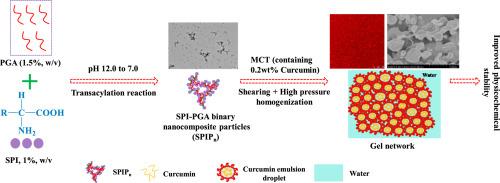通过转酰化反应组装大豆蛋白-海藻酸丙二醇二元纳米复合粒子以稳定高油相姜黄素负载乳状液:凝胶网络的影响
IF 9.8
1区 农林科学
Q1 CHEMISTRY, APPLIED
引用次数: 0
摘要
为了提高乳化剂在复杂环境下的稳定性,采用转酰化反应合成了一种新型乳化剂——大豆分离蛋白(SPI)-海藻酸丙二醇酯(PGA)二元纳米复合颗粒(SPIPn)。结果表明,当PGA中的羧基与SPI中的氨基在各种力的促进下共价结合时,SPIPn形成。SPIPn-2:3是后续制备姜黄素负载乳状液的最合适乳化剂,可使φ低至0.5的乳状液乳化形成乳状液凝胶。此外,φ值的增大增强了凝胶网络结构,从而提高了凝胶的宏观粘度、弹性强度和成乳稳定性。φ为0.6的姜黄素乳状液经过30 d和720 min的辐照后,姜黄素的保留率分别达到96% %和99% %。本研究为提高食品的稳定性提供了一种简便易行的方法。本文章由计算机程序翻译,如有差异,请以英文原文为准。

Assembling soy protein-propylene glycol alginate binary nanocomposite particles via transacylation reaction to stabilize high-oil-phase curcumin-loaded emulsions: Influence of gel network
To make the emulsion more stable under complex environments, a novel emulsifier, soy protein isolates (SPI)-propylene glycol alginate (PGA) binary nanocomposite particles (SPIPn), was synthesized using a transacylation reaction. The findings revealed that SPIPn formed when the carboxyl groups in PGA and the amino groups in SPI were covalently bonded, facilitated by various forces. SPIPn-2:3 was identified as the most suitable emulsifier for the subsequent preparation of curcumin-loaded emulsions and could emulsify emulsions with an φ as low as 0.5 to form emulsion gels. Moreover, an increase in the φ value strengthened the gel network structure, leading to enhanced macroscopic viscosity, elasticity strength, and creaming stability. Furthermore, the emulsion with an φ of 0.6 retained up to 96 % and 99 % of curcumin after storage for 30 days and irradiation for 720 min, respectively. This study could provide a simple and convenient method to improve food product stability.
求助全文
通过发布文献求助,成功后即可免费获取论文全文。
去求助
来源期刊

Food Chemistry
工程技术-食品科技
CiteScore
16.30
自引率
10.20%
发文量
3130
审稿时长
122 days
期刊介绍:
Food Chemistry publishes original research papers dealing with the advancement of the chemistry and biochemistry of foods or the analytical methods/ approach used. All papers should focus on the novelty of the research carried out.
 求助内容:
求助内容: 应助结果提醒方式:
应助结果提醒方式:


